Quiz- Genetics 1
Time limit: 0
Quiz Summary
0 of 38 Questions completed
Questions:
Information
You have already completed the quiz before. Hence you can not start it again.
Quiz is loading…
You must sign in or sign up to start the quiz.
You must first complete the following:
Results
Quiz complete. Results are being recorded.
Results
0 of 38 Questions answered correctly
Your time:
Time has elapsed
You have reached 0 of 0 point(s), (0)
Earned Point(s): 0 of 0, (0)
0 Essay(s) Pending (Possible Point(s): 0)
| Average score |
|
| Your score |
|
Categories
- Not categorized 0%
Would you like to submit your quiz result to the leaderboard?
![captcha]()
Loading
| Pos. | Name | Entered on | Points | Result |
|---|---|---|---|---|
| Table is loading | ||||
| No data available | ||||
- 1
- 2
- 3
- 4
- 5
- 6
- 7
- 8
- 9
- 10
- 11
- 12
- 13
- 14
- 15
- 16
- 17
- 18
- 19
- 20
- 21
- 22
- 23
- 24
- 25
- 26
- 27
- 28
- 29
- 30
- 31
- 32
- 33
- 34
- 35
- 36
- 37
- 38
- Current
- Review
- Answered
- Correct
- Incorrect
-
Question 1 of 38
1. Question
A pharmaceutical researcher develops a therapy to treat a protein misfolding disorder. Specifically, a mutation in this disorder leads to abnormal protein folding and subsequent intracellular degradation of the protein before it can reach the cell membrane. With the new combination drug therapy, the first drug corrects the processing and trafficking of the protein, enabling it to reach the cell surface membrane. Once the protein has reached the cell surface, its function is enhanced by the second drug. This therapy is most likely to be helpful in which of the following conditions?
CorrectIncorrect -
Question 2 of 38
2. Question
A married couple comes to the physician for routine prenatal counseling. The husband is 120 cm (3 ft 11 in) tall with disproportionately short upper and lower extremities, a large head, and a prominent forehead. He is unable to provide a biological family history as he was adopted. His spouse is of average height with normal constitutional features, and her family history is insignificant. They are concerned about their unborn child’s height. Which of the following is the best response to their concerns?
CorrectIncorrect -
Question 3 of 38
3. Question
A 25-year-old Caucasian man is undergoing evaluation for azoospermia. The patient has been monogamous with his long-term girlfriend and does not use contraception during sexual intercourse. They have been trying to conceive for the past year with no success. The patient has a past medical history of recurrent pneumonia with frequent hospitalizations for antibiotic treatment. He takes no medications and does not use tobacco, alcohol, or illicit drugs. The patient has no allergies and his immunizations are up-to-date. His family history is unknown as he was adopted as an infant. Physical examination shows digital clubbing. A transrectal ultrasound shows bilateral absence of the vas deferens. Which of the following tests would most likely confirm the underlying diagnosis of this patient’s condition?
CorrectIncorrect -
Question 4 of 38
4. Question
A 12-year-old boy with mild intellectual disability is brought to the office by his adoptive parents for a routine physical examination. The parents say that the boy is adjusting well to a new school that has increased resources for children with learning disabilities. The patient was adopted as an infant and the birth family’s history is unknown. His immunizations are up to date, and he has no allergies. Review of the patient’s medical records is notable for cytogenetic studies that showed a small gap near the tip of the long arm of the X chromosome. Which of the following findings are likely to be present on this patient’s physical examination?
CorrectIncorrect -
Question 5 of 38
5. Question
A small-for-gestational-age infant is born prematurely to a 38-year-old woman who had inconsistent prenatal care. Physical examination shows a small head and eyes as well as a cleft lip and palate. There is a small, round punched-out lesion with an overlying thin membrane on the patient’s scalp. A small, membranous sac with a loop of bowel protrudes from the patient’s abdominal midline. The infant is transferred to the neonatal intensive care unit for further workup and management. Which of the following is most likely responsible for this patient’s condition?
CorrectIncorrect -
Question 6 of 38
6. Question
A 26-year-old woman is being evaluated for a possible inherited disorder. She has a 6-year history of generalized tonic-clonic seizures, and a year ago, she had partial loss of vision due to an occipital infarction. Her mother has chronic intermittent muscle weakness and lactic acidosis, and her maternal uncle has hemiplegia. Skeletal muscle biopsy of the patient shows ragged-appearing muscle fibers. After further evaluation, all the affected family members are found to suffer from the same inherited disease. Pedigree analysis is shown in the image below.

Which of the following is the most likely explanation for the variability of clinical manifestations in the affected family members?
CorrectIncorrect -
Question 7 of 38
7. Question
A 32-year-old woman, gravida 1 para 0, comes to the office to discuss abnormal laboratory results. The patient is at 18 weeks gestation based on her last menstrual period. She has no chronic medical conditions and takes no daily medications. Results of the quadruple screen performed previously are as follows:
Maternal serum α-fetoprotein
Low
Unconjugated estriol
Low
β-hCG
High
Inhibin A
High
Which of the following is the most likely diagnosis?
CorrectIncorrect -
Question 8 of 38
8. Question
A 19-year-old woman is evaluated for new onset generalized tonic-clonic seizures. For the past several years, she has also been having erratic jerks of her arms and legs, and intermittent muscle weakness. The girl has multiple family members with similar symptoms. Neurological examination reveals decreased sensation in the lower extremities and a broad-based gait. Skeletal muscle biopsy shows ragged, red-appearing muscle fibers. Further analysis reveals that the patient’s symptoms are due to a mutation affecting extranuclear DNA. Which of the following pedigrees is most likely to represent this patient’s family history? (The arrow points to the patient.)
A.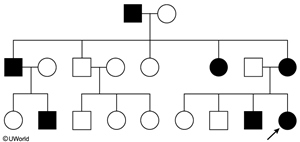 B.
B.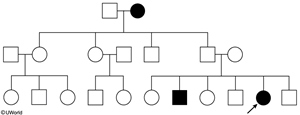 C.
C.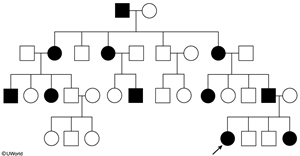 D.
D.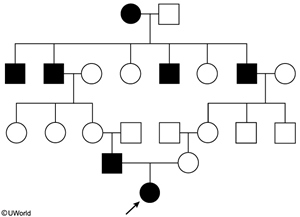 E.
E.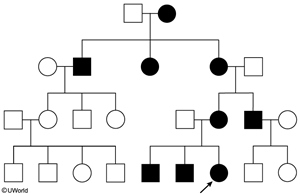 CorrectIncorrect
CorrectIncorrect -
Question 9 of 38
9. Question
A 12-year-old boy with history of seizure disorder experiences several stroke-like episodes with residual neurological deficit. He also suffers from muscle weakness. Blood tests show increased serum lactate levels both post-exercise and at rest. This patient’s condition is known to be maternally inherited. This patient’s sister is also affected by the same disorder, but she displays very few symptoms. Which of the following is the most likely explanation for the variability in clinical presentation between the patient and his sister?
CorrectIncorrect -
Question 10 of 38
10. Question
A 3-year-old boy is brought to the office for follow-up on intellectual disability and speech delay. Review of his developmental screening questionnaire shows that the boy does not imitate his parents’ activities, have a social smile, or show interest in other children. The patient has 8-10 words in his vocabulary and does not combine them into 2-word phrases. There is also concern that his verbal comprehension is poor, and a subsequent audiological evaluation was normal. The boy is up to date on all vaccinations and has no other significant medical history. Laboratory testing shows 226 CGG trinucleotide repeats in a gene located on the X chromosome. Which of the following is the most likely cause of this patient’s clinical condition?
CorrectIncorrect -
Question 11 of 38
11. Question
A 41-year-old man with trisomy 21 is evaluated in the clinic due to cognitive decline. The patient has a history of moderate intellectual disability, but his higher cognitive functions have become progressively impaired in the past several years. He previously volunteered at a community library but recently lost his position as he could no longer perform his duties. The patient is now completely dependent on a caregiver for assistance with his activities of daily living such as getting dressed, bathing, and using the toilet. The patient keeps wandering in the group home and has become lost on several occasions. Which of the following is most likely to be increased in this patient?
CorrectIncorrect -
Question 12 of 38
12. Question
A 23-year-old man is being evaluated for myoclonic epilepsy of recent onset. The episodes are short-lived and triggered by startle. Physical examination reveals proximal muscle weakness. Gomori trichrome stain of a muscle biopsy specimen shows muscle fibers with a blotchy red appearance. No family history is available because the patient is adopted. What is the probability that this patient’s one offspring will inherit the disease?
CorrectIncorrect -
Question 13 of 38
13. Question
A study is undertaken to map the HLA-DQ loci in a population with a high incidence of celiac sprue. High-resolution HLA typing of the DQA1 and DQB1 loci is performed using polymerase chain reaction sequencing. The frequency of the DQA1*0501-DQB1*0201 haplotype, strongly implicated in autoimmunity, is found to be 0.2. However, in the same population, the frequency of the DQA1*0501 allele is 0.3 and the frequency of the DQB1*0201 allele is 0.2. Which of the following best explains the observed DQA1*0501-DQB1*0201 haplotype frequency in this population?
CorrectIncorrect -
Question 14 of 38
14. Question
A 26-year-old woman comes to the office with her husband for genetic counseling. She is pregnant with their second child, whose gender is unknown. Both parents are asymptomatic, but their firstborn 3-year-old son has recurrent episodes of anemia, jaundice, and painful swelling of the hands and feet. A blood sample is obtained from the boy, and hemoglobin electrophoresis is performed at alkaline pH. The results are shown in the image below.

What is the probability that the unborn child will inherit one or more mutant alleles from the parents?
CorrectIncorrect -
Question 15 of 38
15. Question
A 4-year-old boy is brought to the office due to a progressively worsening cough for the past 2 days that is productive of yellow sputum. A year ago, he was found to have bilateral lower-lobe pulmonary infiltrates on chest x-ray and was diagnosed with pneumonia. The patient has since had 2 additional episodes of pneumonia, each requiring antibiotics for improvement of symptoms. His current chest x-ray again reveals bilateral lower lobe infiltrates. Further testing shows a high chloride content in his sweat. Which of the following abnormalities is most likely to be seen in this patient?
CorrectIncorrect -
Question 16 of 38
16. Question
A newborn girl is evaluated in the nursery after an uncomplicated spontaneous vaginal delivery to a 29-year-old primigravida. The mother declined prenatal testing and ultrasound examination while pregnant. She took prenatal vitamins throughout the pregnancy, which was otherwise uneventful. Examination of the neonate shows a posterior neck mass and bilateral nonpitting edema of the hands and feet. She has low-set ears and a high-arched palate. Femoral pulses are diminished. The remainder of the examination is normal. Ultrasonography of the neck reveals a mass composed of cystic spaces separated by connective tissue. Which of the following is the most likely underlying mechanism responsible for this patient’s condition?
CorrectIncorrect -
Question 17 of 38
17. Question
A 32-year-old woman comes to the office due to worry that she will go bald. Her father had a receding hairline with apical baldness beginning at age 20 and was completely bald by age 35. The patient’s paternal grandmother and multiple other relatives on her paternal side also had early-onset baldness, but her father’s siblings and the maternal side of her family have had no problems with unusual hair loss. Physical examination shows mild thinning of hair at the temporal areas, with an otherwise normal hairline, thickness, and coloration. There is no excess hair growth on her face or trunk, and she has a normal female pattern of pubic hair growth. Palpation of the thyroid is normal. Which of the following is the most likely inheritance pattern of the hair loss in this patient’s family?
CorrectIncorrect -
Question 18 of 38
18. Question
A patient is suspected of having an inherited disorder. Pedigree analysis shows the following pattern:

This patient most likely has which of the following conditions?
CorrectIncorrect -
Question 19 of 38
19. Question
A boy is admitted to the neonatal intensive care unit shortly after being born to a 28-year-old woman who had poor prenatal care. His temperature is 37.2 C (99 F), blood pressure is 70/30 mm Hg, pulse is 128/min, and respirations are 40/min. Pulse oximetry shows 85% on room air. Physical examination is significant for orbital hypertelorism, a submucous cleft palate, and bifid uvula. An echocardiogram reveals right ventricular hypertrophy, pulmonary stenosis with ventricular septal defect, and overriding aorta. The patient’s diagnosis is eventually confirmed by fluorescence in situ hybridization. These findings are most consistent with which of the following mechanisms?
CorrectIncorrect -
Question 20 of 38
20. Question
A 1-day-old infant in the newborn nursery is found to have a harsh, holosystolic murmur on physical examination. The neonate was born at 39 weeks gestation to a 36-year-old woman who opted to defer prenatal screening. Review of medical records shows no family history of genetic or chromosomal disorders. The infant’s vital signs are appropriate for his age. The rest of the physical examination shows a flat facial profile, protruding tongue, and small ears. Which of the following most likely occurred prior to conception?
CorrectIncorrect -
Question 21 of 38
21. Question
An infant born to a 26-year-old woman is evaluated shortly after delivery. Birth weight and length are at the 10th and 15th percentiles, respectively. Vital signs are normal. Physical examination shows a protruding tongue, excessive skin at the nape of the neck, and upslanting palpebral fissures. The startle reflex is symmetric and weak. Cardiac auscultation reveals a harsh, III/VI systolic murmur heard best over the lower left sternal border. The patient has normal external female genitalia. Review of maternal medical records shows a past history of 2 spontaneous abortions in the last 3 years. Echocardiography confirms the presence of a ventricular septal defect. Which of the following karyotypes is most likely to be found in this infant?
CorrectIncorrect -
Question 22 of 38
22. Question
A 16-year-old boy with mild intellectual disability is brought to the office to be evaluated for attention deficit-hyperactivity disorder. The parents state that he has always been impulsive and inattentive and that teachers are concerned about his inattentiveness and poor grades. Review of medical records shows a history of gross motor and speech delay for which he received physical and speech therapies during childhood. On physical examination, the boy has a long and narrow face, a prominent mandible, and large testes. There is hyperlaxity of his finger and thumb joints. Which of the following is the most likely diagnosis in this patient?
CorrectIncorrect -
Question 23 of 38
23. Question
A 33-year-old primigravida comes to the office to discuss the results of prenatal testing. The patient is at 16 weeks gestation. Maternal serum alpha-fetoprotein is reduced, and ultrasound reveals increased nuchal translucency. Amniocentesis shows a fetal karyotype of 47,XX,+21. This fetus is at greatest risk of having which of the following embryologic malformations?
CorrectIncorrect -
Question 24 of 38
24. Question
A 14-year-old boy experiences severe, prolonged bleeding following a tooth extraction. He also has a history of multiple episodes of painful joint swelling following minor trauma. His parents have no bleeding problems. Evaluation shows that the patient has an inherited disorder and that one of his parents is a genetic carrier. His older sister, who does not have this condition, is pregnant. She does not know the sex of her child. She asks about the risk that her child will be affected. Which of the following is the best estimate that this child will have the disease?
CorrectIncorrect -
Question 25 of 38
25. Question
A 1-hour-old girl born to a 40-year-old woman is brought to the nursery for evaluation. The pregnancy and delivery were uncomplicated. Physical examination shows mid-face hypoplasia with a flat nasal bridge, up-slanting palpebral fissures, a small mouth, and a single palmar crease bilaterally. Cardiac auscultation reveals a blowing holosystolic murmur heard best along the sternal border. Which of the following abnormalities is most likely to be present in this patient?
CorrectIncorrect -
Question 26 of 38
26. Question
An infant born to a 34-year-old woman has a flat facial profile, prominent epicanthal folds, and a holosystolic murmur heard loudest at the left sternal border. Karyotype analysis is consistent with trisomy 21. Maternal and paternal karyotypes are normal. A restriction fragment length polymorphism (RFLP) analysis is conducted to determine the parental origin of the extra chromosome. DNA samples from the child, mother, and father are obtained and the DNA is fragmented with a restriction enzyme. The fragments are then sorted by size using the Southern blot technique. Labeling is done using a probe that binds to a specific DNA sequence close to the centromere of chromosome 21. RFLP analysis for the child, mother, and father is shown below.

In which of the following meiosis events did the nondisjunction most likely occur?
CorrectIncorrect -
Question 27 of 38
27. Question
A 28-year-old man is evaluated for abnormal movements of the hands and face. The patient reports that he started experiencing involuntary grimacing a year ago, which has gradually worsened. He is taking a selective serotonin reuptake inhibitor for major depression but has not taken any antipsychotic medications. His 52-year-old father was diagnosed with an inherited movement disorder 2 months ago. Physical examination shows normal strength and normal deep tendon reflexes. No sensory deficits are noted. Which of the following best explains the difference in disease presentation between this patient and his father?
CorrectIncorrect -
Question 28 of 38
28. Question
A healthy 31-year-old woman comes to the office as she and her husband desire a second child. The husband is infertile and the patient’s son, who was conceived via donor insemination, was recently diagnosed with glycogen storage disease type II (Pompe disease). This rare autosomal recessive disease is known to affect 1 in 40,000 of the general population. Genetic testing confirms that the patient is a carrier for the disease. A different sperm donor is selected with no personal or family history of Pompe disease; however, his carrier status is unknown. What is the probability of the patient having an affected child with the new sperm donor?
CorrectIncorrect -
Question 29 of 38
29. Question
A 22-year-old woman, who recently relocated, comes to the office for a new patient visit. She has mild intellectual disability and has completed a high school level of education. The patient has no major health problems but reports persistent swelling of the hands and feet. Menarche occurred at age 13, and she has regular menstrual cycles. Physical examination shows short stature and a webbed neck. Karyotype analysis performed on peripheral leukocytes shows that 40% of the cells have a 45,X genotype and that the remaining 60% contain a 46,XX genotype. Which of the following is the most likely cause of this patient’s condition?
CorrectIncorrect -
Question 30 of 38
30. Question
A young couple has undergone a successful in vitro fertilization procedure. The father has cystic fibrosis and the mother has a sister with cystic fibrosis. The father as well as the mother’s sister are both known to have ΔF508 mutations, but the mother’s carrier status is unknown. Before making the decision to conceive, the couple underwent extensive genetic counseling regarding the potential risks of having a child with cystic fibrosis. The family pedigree is diagrammed below with the unborn child marked by the red arrow.

What is the probability that the unborn child will have cystic fibrosis?
CorrectIncorrect -
Question 31 of 38
31. Question
A healthy couple, who recently emigrated from Eastern Europe, brings their 3-year-old son to the office for evaluation of an eczematous rash. On examination, the child also shows signs of intellectual disability and gait abnormality and has a musty body odor. Which of the following is the likelihood that this couple’s next child will be affected with the same disease?
CorrectIncorrect -
Question 32 of 38
32. Question
A 5-year-old boy is being evaluated for progressive muscle weakness that has resulted in numerous recent falls. There is no family history of muscle disorders. Physical examination reveals bilateral calf enlargement. When the patient is asked to stand, he uses his hands and arms to help push himself to an upright position. Serum creatine kinase is 12,600 U/L (normal: 30-170 U/L). Molecular tests reveal a large muscle protein that is defective due to the loss of 508 amino acid residues. Genetic analysis reveals a single base substitution within exon 48 of the gene encoding this muscle protein. This patient’s gene mutation has most likely resulted in which of the following mRNA codon changes?
CorrectIncorrect -
Question 33 of 38
33. Question
A 35-year-old woman, gravida 1 para 0, at 20 weeks gestation comes to the office for a routine prenatal visit and fetal anatomy ultrasound. The ultrasound reveals several abnormalities. An amniocentesis is performed and a fetal karyotype analysis is ordered; the results are shown in the image below:

This fetus is at greatest risk for developing which of the following conditions after birth?
CorrectIncorrect -
Question 34 of 38
34. Question
A 10-year-old boy is brought to the emergency department for new swelling in his right leg. He has a history of lens dislocation and intellectual disability. Physical examination demonstrates moderate, pitting edema from his right calf to his right thigh and a normal left lower extremity. In addition, the patient has a caved-in appearing chest wall. He has no family members with similar conditions. Ultrasound reveals a deep venous thrombosis in his right femoral vein. Further genetic testing reveals a single missense mutation in the gene coding for cystathionine beta-synthase enzyme. Which of the following is the most likely explanation for this patient’s genetic defect affecting multiple tissues?
CorrectIncorrect -
Question 35 of 38
35. Question
A pharmaceutical researcher is evaluating a nuclear enzyme inhibitor for the treatment of an inherited disorder. During an experiment, he extracts and purifies nuclear enzymes from skin cells of an affected patient. One of these enzymes is found to catalyze the methylation of cytosine residues in DNA using S-adenosyl-methionine (SAM) as the methyl donor. This enzyme most likely plays a crucial role in which of the following genetic processes?
CorrectIncorrect -
Question 36 of 38
36. Question
A newborn is examined immediately after an induced vaginal delivery for fetal growth retardation. On visual inspection, the infant has low-set ears, a small mandible, and a prominent occiput. The neonate has a weak cry and increased tone of the extremities, including clenched hands with second and fifth digits on top of the third and fourth digits. Cardiac auscultation reveals a harsh, IV/VI holosystolic murmur heard best at the left sternal border. The infant is transferred to the neonatal intensive care unit for further workup and management. Which of the following is the most likely chromosomal abnormality in this infant?
CorrectIncorrect -
Question 37 of 38
37. Question
A 54-year-old man comes to the physician with recent-onset mild headaches and left leg weakness. Numerous lesions are seen on physical examination, as shown below.

Which of the following inheritance patterns is this patient’s disorder most likely to exhibit?
CorrectIncorrect -
Question 38 of 38
38. Question
A researcher is studying the expression pattern of a particular gene. Messenger RNA is isolated from several tissues, subjected to electrophoresis, blotted, and probed with radiolabeled DNA containing sequences from exon 4 from that gene. An x-ray film is then placed over the blotting membrane, with the results of the autoradiogram shown below:

Which of the following best explains the autoradiogram findings in the different tissues?
CorrectIncorrect
